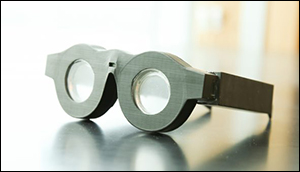Smart glasses that automatically focus on what wearer sees
27. 1. 2017 | University of Utah | unews.utah.edu
A team led by University of Utah electrical and computer engineering professor Carlos Mastrangelo and doctoral student Nazmul Hasan has created “smart glasses” with liquid-based lenses that can automatically adjust the focus on what a person is seeing, whether it is far away or close up.
Mastrangelo and Hasan have created eyeglass lenses made of glycerin, a thick colorless liquid enclosed by flexible rubber-like membranes in the front and back. The rear membrane in each lens is connected to a series of three mechanical actuators that push the membrane back and forth like a transparent piston, changing the curvature of the liquid lens and therefore the focal length between the lens and the eye.

The lenses are placed in special eyeglass frames also invented by Mastrangelo, Hasan and other members of the research group with electronics and a battery to control and power the actuators. In the bridge of the glasses is a distance meter that measures the distance from the glasses to an object via pulses of infrared light. When the wearer looks at an object, the meter instantly measures the distance and tells the actuators how to curve the lenses.
If the user then sees another object that’s closer, the distance meter readjusts and tells the actuators to reshape the lens for farsightedness. Hasan says the lenses can change focus from one object to another in 14 milliseconds. A rechargeable battery in the frames could last more than 24 hours per charge, Mastrangelo says.
Read more at University of Utah
Image Credit: Dan Hixson
-jk-




